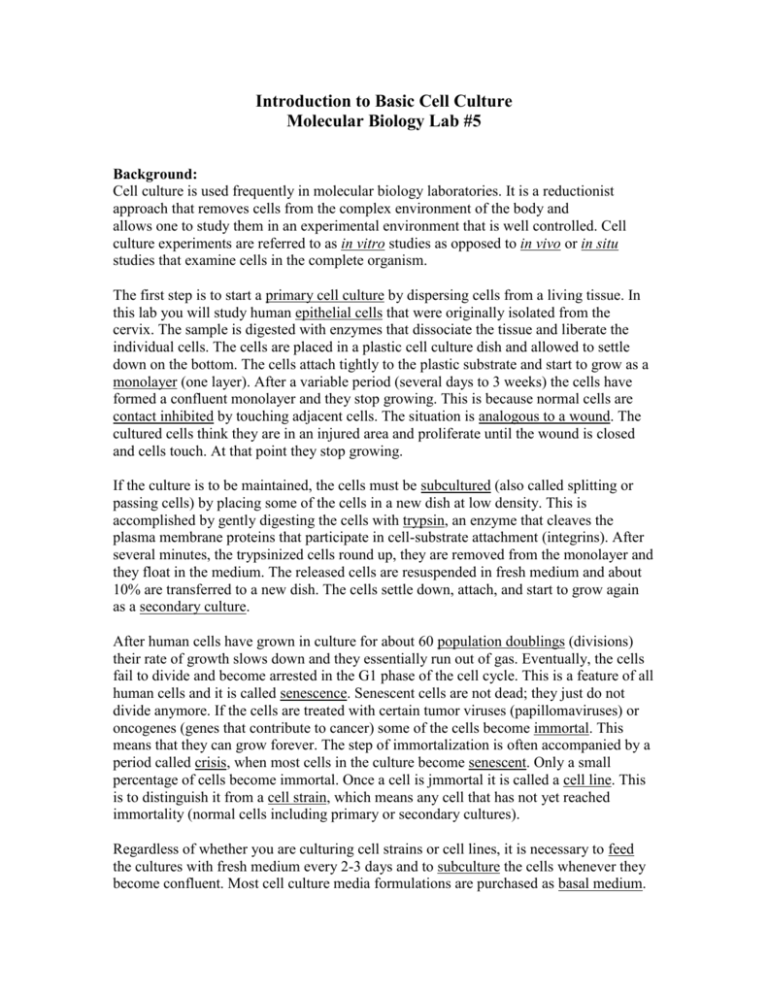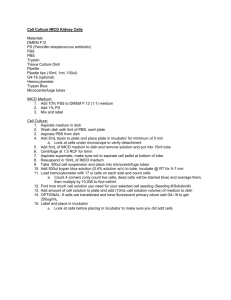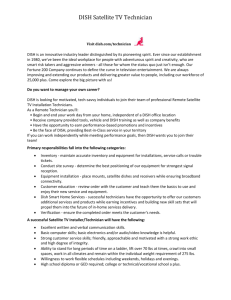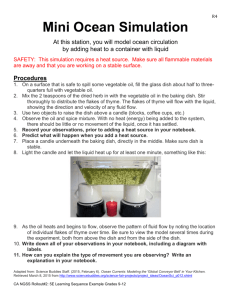Molecular Biology Lab 6 Basic Cell Culture
advertisement

Introduction to Basic Cell Culture Molecular Biology Lab #5 Background: Cell culture is used frequently in molecular biology laboratories. It is a reductionist approach that removes cells from the complex environment of the body and allows one to study them in an experimental environment that is well controlled. Cell culture experiments are referred to as in vitro studies as opposed to in vivo or in situ studies that examine cells in the complete organism. The first step is to start a primary cell culture by dispersing cells from a living tissue. In this lab you will study human epithelial cells that were originally isolated from the cervix. The sample is digested with enzymes that dissociate the tissue and liberate the individual cells. The cells are placed in a plastic cell culture dish and allowed to settle down on the bottom. The cells attach tightly to the plastic substrate and start to grow as a monolayer (one layer). After a variable period (several days to 3 weeks) the cells have formed a confluent monolayer and they stop growing. This is because normal cells are contact inhibited by touching adjacent cells. The situation is analogous to a wound. The cultured cells think they are in an injured area and proliferate until the wound is closed and cells touch. At that point they stop growing. If the culture is to be maintained, the cells must be subcultured (also called splitting or passing cells) by placing some of the cells in a new dish at low density. This is accomplished by gently digesting the cells with trypsin, an enzyme that cleaves the plasma membrane proteins that participate in cell-substrate attachment (integrins). After several minutes, the trypsinized cells round up, they are removed from the monolayer and they float in the medium. The released cells are resuspended in fresh medium and about 10% are transferred to a new dish. The cells settle down, attach, and start to grow again as a secondary culture. After human cells have grown in culture for about 60 population doublings (divisions) their rate of growth slows down and they essentially run out of gas. Eventually, the cells fail to divide and become arrested in the G1 phase of the cell cycle. This is a feature of all human cells and it is called senescence. Senescent cells are not dead; they just do not divide anymore. If the cells are treated with certain tumor viruses (papillomaviruses) or oncogenes (genes that contribute to cancer) some of the cells become immortal. This means that they can grow forever. The step of immortalization is often accompanied by a period called crisis, when most cells in the culture become senescent. Only a small percentage of cells become immortal. Once a cell is jmmortal it is called a cell line. This is to distinguish it from a cell strain, which means any cell that has not yet reached immortality (normal cells including primary or secondary cultures). Regardless of whether you are culturing cell strains or cell lines, it is necessary to feed the cultures with fresh medium every 2-3 days and to subculture the cells whenever they become confluent. Most cell culture media formulations are purchased as basal medium. This contains all the ingredients needed to maintain cells in culture (amino acids, vitamins, salts, glucose, buffers, phenol red, etc ). The basal media is usually supplemented with 5-10% fetal bovine serum as a source of growth factors needed to allow cells to grow rapidly in culture. This is called complete medium- Serum is easy to use and efficiently stimulates growth of most cells, however, it is also an undefined substance. Different preparations (or lots) of serum vary in potency and most scientists prefer to culture cells in a medium that is completely defined. There are a number of serum-free media that are commercially available for specific cell types. The advantage of these media is that the components are well defined and the scientist knows exactly what is going into the cells. The disadvantage of serum-free medium is that it is difficult to discover the right combination of growth factors that stimulate each different type of cell. In addition, serum free media are often relatively expensive because one must purchase all of the purified growth factors. Cell culture medium usually has a red color. This is due to the presence of phenol red, a pH indicator. At pH 7, the optimal pH for cell growth and survival, the dye appears orange-red. At lower pH values, the dye turns yellow, and at alkaline values the dye turns purple. The pH is buffered by adding bicarbonate to the medium. The bicarbonate in the medium combines with CO2 in the cell culture incubator to balance the pH at 7. Usually, the incubator injects CO2 into the atmosphere at 5% to accomplish this end. The incubator also keeps the cells warmed to 37°C. Cells can survive well at lower temperatures (although they will grow more slowly), but cells quickly die if the temperature of the incubator exceeds 40°C. Finally, the incubator also provides humidity to the cell culture to prevent the culture dishes from drying out. Cultured cells can be cryopreserved by freezing in liquid nitrogen. This is useful if one is working with a large number of cell lines. When a particular cell line is no longer needed for the experiment it can be temporarily frozen so that you do not need to continually feed and pass the cells. This saves time and money. Cells are routinely frozen by resuspending in medium with 10% DMSO and placing cells in cryovials at -80°C. The DMSO prevents formation of large ice crystals during the slow process of cell freezing. After 24 hours, the frozen cells are moved to liquid nitrogen for long term storage (-80°C is not cold enough). Cells are stable in liquid nitrogen for many years. They can be returned to cell culture simply by retrieving a vial from the freezer, warming at 37°, and adding cells to fresh medium. Sterile technique is very important when performing routine cell culture. The process of working with cells usually occurs in a laminar flow hood. This hood uses a stream of filtered, sterile air to keep the working surface clean. Cell culture can also be performed in a static hood. This hood has a covered area to work in but there is no sterile airflow. Thus, it is important to flame sterilize objects that will come in contact with cells (pipettes, medium bottles, instruments) when working in the static hood. One of the major problems in cell culture is contamination by microorganisms. Using several antibiotics in the cell culture medium usually prevents potential contamination. If your culture technique was perfect, antibiotics would not be needed. However, most labs 2 use an anti-bacterial agent (penicillin or streptomycin) and an anti-mycotic solution (fungizone for fungus and yeast) to protect against contamination. Objectives: The objective of this lab is to introduce you to basic information about cell culture and to provide hands on experience in splitting and freezing a cell line. Materials: Laminar flow hood CO2 incubator Inverted microscope Table top centrifuge Bunsen burner Vacuum flasks and tubing Sterile pipettes (serological and Pasteur) Cell culture medium 100 mm cell culture dishes trypsin solution phosphate buffered saline rubber bulbs 70% ethanol and Clorox cryovials liquid nitrogen storage container -70°C freezer 37°C water bath cell cultures frozen cultures 15 ml conical centrifuge tubes cell freezing medium with DMSO cell splitting medium with 5% bovine serum Methods: Hood clean up: Turn on the visible light and turn off the UV light (if available). Start by cleaning the working surface of the hood. Wash the surface with 70% ethanol and dry with a paper towel. Turn on the flame and vacuum. Place the vacuum hose in the bottle of Clorox and suck about 50 ml through the hose to clean. Cell feeding: 1. Remove a Pasteur pipette from the can and connect the end to the vacuum hose. Remove the top of the cell culture dish and set upside down. Suck the old medium out of the culture dish. 3 2. Open the bottle of medium and place the cap upside down on the surface of the hood. Open a can of sterile tissue culture pipettes and remove a 10 ml pipette. Attach the pipette to a bulb and remove 4 ml of medium from the bottle. Add to the empty dish. 3. Place used pipettes in the pail or pan. Cell splitting: 4. Remove a Pasteur pipette from the can and attach to the vacuum tubing. Remove the top of the cell culture dish and set upside down. Use the pipette to suck the old medium out of the culture dish. 5. Open the bottle of phosphate buffered saline (PBS). Open a can of sterile tissue culture pipettes and remove a 10 ml pipette. Attach the pipette to the bulb and remove 4 ml of PBS from the bottle and add to the empty dish. 6. Rinse the dish for 10-20 seconds to remove serum or other proteins that inhibit action of trypsin. Using another Pasteur pipette, remove the PBS. Add 2 ml of trypsin solution to the dish and place the dish at 37°C in the incubator. Check the dish under the inverted microscope every 2-3 minutes to see whether the cells have started to round up and detach from the substrate. This process usually requires 10 min. 7. When all of the cells have rounded up and are free of the substrate, add 2 ml of serum-containing medium to neutralize the trypsin. Gently mix the cells and medium using a 10 ml pipette and add contents (4 ml) to a 15 ml conical centrifuge tube. 8. Spin the tube at low speed (setting 2) for 3-4 minutes to pellet the suspended cells. 6. Remove the tube from the centrifuge and suck away the medium using a Pasteur pipette attached to the vacuum line. Resuspend the cell pellet in 4 ml of medium and mix gently using a 10 ml pipette. 7. Add 0.4 ml of cell suspension to a new cell culture dish (60mm dish) containing 4 ml of medium. Move the dish to the incubator and rock back and forth at right angles to mix up the cells and distribute them evenly throughout the culture. Label with a piece of tape that says 'do not disturb' and place in the rear of the incubator. 8. Place any used cell culture dishes or centrifuge tubes in the biohazard bag. 4 Cell freezing: 1. Follow steps 1-5 for splitting cells. 2. Resuspend the pellet in 2 ml of cell culture medium. Add 100 l of cells to a new 60 mm culture dish in 4 ml of medium (if you wish to maintain the cells in culture). 3. Add 2 ml of cell freezing medium to the centrifuge tube and mix with a pipette. 4. Add 1 ml of the cell suspension to a cryovial and attach cap. Label the cryovial with date, your initials, and the name of the cell line. 5. Transfer the cryovial to the -80°C freezer for 24 hours to allow cells to freeze slowly. 6. After 24 hours, place cryovials in the liquid nitrogen container. Put on goggles to protect your eyes! Use a glove to remove a basket from the large nitrogen container. Be careful that liquid nitrogen does not spill on you or others. Remove one of the canes from the basket and snap the frozen cryovial into the metal holders. Make sure it is snug, then return the cane to the basket and replace in the storage tank. 7. To bring back a cell line that was previously frozen in liquid nitrogen, first put on eye protection. Use the glove to remove a basket and cane from the storage tank. Take one of the cryovials from the cane and immediately loosen the cap (the vials can explode if they warm up and the cap is not loosened). Place the frozen vial in a boat in the 37°C water bath for 2- 3 min to thaw. 8. Open the cryovial and briefly flame the top. Withdraw the cell suspension with a 1 ml pipette and place into a 60 mm cell culture dish with 4 ml of fresh medium. Transfer to the incubator and label 'do not disturb'. Hood clean up: After you have finished, suck about 50 ml of Clorox through the vacuum line to clean. Turn off the gas and the vacuum. Wash the work surface of the hood with 70% ethanol. Turn off the regular light and turn on the UV light (if available) to sterilize the hood. If the large suction flask is full, please remove rubber stopper and pour contents down sink. Clean up the area and put materials back in the refrigerator! 5






